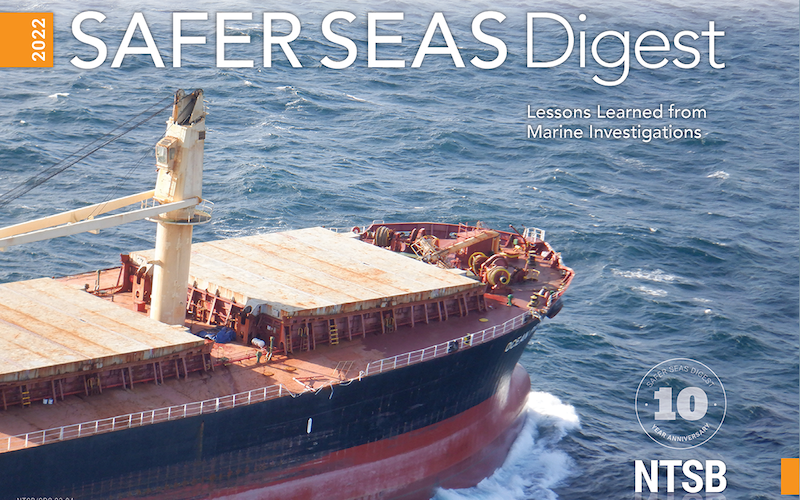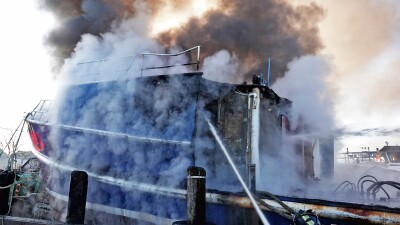In October, the National Transportation Safety Board (NTSB) released its most recent Safer Seas Digest, which highlights the critically important lessons learned from marine investigations last year. The 2023 edition won’t be published until later this year.
The 2022 edition provides analysis into 29 maritime casualties: two capsized vessels, three collisions, seven contacts made, nine fires/explosions, one flooding/hull failure, six groundings/strandings, and one vessel that experienced machinery damage. The report also provides a table of vessel particulars by vessel group and corresponding casualty location. This year’s report contained seven fishing vessel accidents.
“With every investigation, our mission is the same: to determine what happened, how it happened, and issue evidence-based recommendations to prevent similar events from occurring in the future,” NTSB Chair Jennifer Homendy, said in the Safer Seas Digest for 2022.
The Safer Seas Digest 2022 is available online, as well as a library of previous editions spanning the past decade. In the past two editions of the Safer Seas Digest, the NTSB has continued to make life-saving recommendations to the Coast Guard and others advocating the use of personal locator beacons.
THE SINKING OF THE F/V EMMY ROSE
On Nov. 17, 2020, the 82’x23’x9’ F/V Emmy Rose, carrying a four-person crew and 34,000 pounds of ice, left Portland, Maine at around 4 pm. Four days later, at approximately 6:30 pm, the Emmy Rose was last identified on the Vessel Monitoring System (VMS) to be 27 miles northeast of Provincetown, Massachusetts, departing the fishing grounds at a speed of 7 knots on a course of 277° and headed for Gloucester, Mass. The forecast from the National Weather Service (NWS) predicted southeast winds at 15–20 knots with gusts up to 25 knots, accompanied by seas ranging from 5 to 8 feet high. Additionally, there was a forecast for patchy fog and a chance of showers after midnight.
At 1:30 am the following morning, the U.S. Coast Guard in Boston, Mass. received a distress call from the fishing vessel. Search and Rescue (SAR) efforts continued for 38 hours and covered over 2,200 square miles. During the search, Coast Guard personnel recovered the EPIRB, the liferaft, one life ring, and two wooden fish hold hatch covers from the Emmy Rose. The vessel sank in 794 feet of water and was not recovered.
In May 2021, side scan sonar and a ROV were used to locate and survey the sunken vessel, 27 miles northeast of Provicetown, Mass. The estimated value of the Emmy Rose was $325,000.
The NTSB found that the probable cause of the F/V Emmy Rose sinking was a sudden loss of stability caused due to water collecting on the aft deck and subsequently flooding the vessel through deck hatches, which were not secured as required by the vessel's stability instructions and commercial fishing regulations.
FIRE ABOARD THE FISH PROCESSER ALEUTIAN FALCON
On the evening of February 17, 2021, at approximately 10:30 pm, a fire broke out aboard the 233’x39’x11’ commercial fish processor Aleutian Falcon. This incident occurred while the vessel was undergoing repairs at the Trident Seafoods shipyard in Tacoma, Washington.
The day of the fire was marked by a planned continuation of hot work activities. Specifically, the workers were tasked with removing corroded steel deck plating situated on the bridge deck, directly above the pantry, dry stores area, and a walk-in refrigerator. Given the proximity of this work to foam insulation below, a marine chemist had been brought on board to assess the involved areas. The port engineer, shipyard worker, and lead welder, all holding supervisory roles, were fully aware that the replacement of the deteriorated deck plating necessitated both the removal of old steel and the welding of new steel into place. Consequently, they should have recognized that the spaces immediately beneath the deck would be susceptible to flames, heat, and sparks.
Following an investigation, the NTSB determined that the primary cause of the fire aboard the Aleutian Falcon was inadequate planning by the company's supervisory personnel in relation to hot work. Furthermore, shoreside workers failed to adequately protect the hot work areas, allowing slag from the welding process to ignite combustible materials near an insulated wooden bulkhead within a walk-in refrigerator that had not been removed or adequately safeguarded. Contributing to this unfortunate incident was the ineffective communication among the supervisory personnel, marine chemist, and the workers involved.
The fire, which lasted over four days, resulted in no injuries but caused the vessel to be declared a constructive total loss with an estimated value of $16,460,850.
FIRE ABOARD F/V BLUE DRAGON
On November 10, 2021, at about 12:15 am, the 85’x25’x11’ F/V Blue Dragon was navigating the North Pacific Ocean, situated 350 miles offshore of Monterey, California. The vessel was actively engaged in longline fishing operations when an unexpected fire erupted. Despite valiant efforts by the Blue Dragon's six crew members and a National Marine Fisheries Service observer to combat the blaze, their endeavors proved unsuccessful. Subsequently, they made the difficult decision to abandon the vessel and were later rescued by a Good Samaritan vessel. The Blue Dragon was subsequently towed to San Pedro, California, and notably, no reports of pollution or injuries were filed. The damage to the vessel was assessed at an estimated cost exceeding $500,000.
The primary cause of the fire on board the fishing vessel Blue Dragon was traced back to an unknown source, believed to be an electric incident, which triggered the ignition of the wooden wheelhouse console. A significant contributing factor to the extensive damage caused by the fire was the extensive use of combustible materials in the wheelhouse's joinery, outfitting, and furnishings, as well as in the accommodation spaces. The substandard nature of the vessel's electrical installations and outfitting emerged as a recurring issue, encompassing bare wires, inadequately secured wire nuts, overloaded circuits, loose wiring, and the use of household wiring unsuited for marine applications..
In this casualty, personal locator beacons (PLBs) helped validate the position of the vessel’s emergency position indicating radio beacon (EPIRB), and a satellite emergency notification device (SEND) helped responders identify the nature of the emergency. Vessel owners and operators can enhance the safety of their crews by equipping their vessels and crews with these additional satellite technologies to supplement EPIRBs.
FIRE ABOARD F/V NOBSKA
On April 30, 2021, around 6:10 pm, a fire erupted aboard the 100’x25’x14’ F/V Nobska while the five-member crew was ground fishing in Georges Bank, about 80 miles east of Cape Cod, Massachusetts. The fire started in the engine room and quickly engulfed the vessel. When attempts to extinguish the fire proved unsuccessful, the crew prepared to abandon ship and activated the vessel’s EPIRB. A Coast Guard helicopter rescued the crew from the stern of the fishing vessel. Neither injury nor pollution was reported. The Nobska, valued at an estimated $2.4 million, was declared a total constructive loss.
The NTSB's investigation into the fire on the fishing vessel Nobska pointed to the probable cause being the failure of a hydraulic hose within the engine room. This failure allowed hydraulic fluid to spray onto a hot surface, believed to be the exposed main engine exhaust pipe. It is noteworthy that potential heat damage from an earlier fire that occurred on the same day contributed to the hydraulic hose's failure.
The vessel featured a vertical tunnel extending from the engine room up two decks to the wheelhouse, lacking crucial insulation, pipe/cable fire stops, or other barriers designed to impede the passage of smoke, heat, and fire—collectively known as structural fire protection. Such an unprotected vertical tunnel presents the risk of enabling the rapid spread of fire outside its originating space. Vessel owners and operators are strongly encouraged by NTSB to identify openings between decks and ensure they implement structural fire protection measures to prevent the unwarranted expansion of fires.
GROUNDING AND SINKING OF F/V SAGE CATHERINE LANE
On June 9, 2021, around 0915 am, the 79’x20’x7’ F/V Sage Catherine Lane was transiting outbound on the St. Marys River, south of Cumberland Island, Georgia, when the vessel grounded on the north jetty of the St. Marys Entrance. Shortly thereafter, the vessel began to take on water. In response to this situation, the three-member crew opted to abandon the Sage Catherine Lane, ultimately being rescued by the crew of a nearby good samaritan vessel. It was estimated that roughly 2,300 gallons of fuel, engine oil, and hydraulic oil were aboard, with approximately 800 gallons successfully recovered. A noticeable sheen emerged following the vessel's breakup, occurring three days later. Notably, one crewmember sustained a minor injury, but there were no further reported casualties. The loss of the vessel was valued at approximately $1 million.
The NTSB found that the probable cause of the grounding of the fishing vessel Sage Catherine Lane was the captain’s decision to leave the wheelhouse unattended as the vessel transited the St. Marys Entrance on autopilot, leaving insufficient time to respond when the autopilot failed and caused the vessel to go off the set course.
A crucial lesson can be drawn from this incident concerning the use of autopilot systems. It underscores that utilizing autopilot does not absolve the operator of the responsibility to maintain a vigilant navigation watch. Operators should refrain from leaving the wheelhouse or bridge unattended, particularly in confined waters where quicker reaction times are imperative due to factors such as traffic, currents, frequent course adjustments, and the increased use of rudder at lower speeds. As a result, the use of autopilot is often discouraged or even prohibited in harbor entrances or narrow channels.
GROUNDING OF FISHING TENDER BARGE SM-3
On August 30, 2020, around 10:00 pm, the 150’x42’x6’ fishing tender barge SM-3 was anchored and riding out a storm with a crew of six in Nushagak Bay, 5 miles south of Ekuk, Alaska, when the barge broke free from the buoy and began drifting.. The crew deployed two emergency anchors but were unable to prevent the grounding. The following morning, the crew evacuated the vessel and were picked up by locals. There was a 3-mile debris field on the beach. No injuries were reported. The barge was later salvaged. Damage to the vessel was estimated at $4.5 million.
The probable cause of the grounding was attributed to a fatigue crack in one of the mooring buoy's padeye welds, causing it to separate from the buoy's spherical steel plating during the storm.
NTSB stresses that in addition to ensuring mooring chains possess sufficient length to allow for adequate scope during anchorages, mariners must meticulously evaluate the strength of each component within their ground tackle system. To this end, they should reference marine standards when designing these systems. Bending loads, which can exert significantly higher forces than straight-line pulls, should be taken into account. It is imperative that the working load limit of each component equals or surpasses the maximum calculated load of the ground tackle system to prevent vulnerabilities and weak points within the system.
GROUNDING AND SINKING OF FISHING VESSEL TENACIOUS
On July 24, 2021, around 3:30 am, the 52’x16’x6’ F/V Tenacious ran aground at the entrance to Wells Passage, Alaska, due to the captain's decision to get underway while fatigued. The crew had been running on limited sleep, and the captain had been awake for 19.5 hours at the time of the accident, likely impaired by acute fatigue and chronic sleep debt. Two thousand gallons of diesel fuel were on board and not recovered. One minor injury was reported. Loss of the vessel and fishing gear totaled an estimated $660,000.
The NTSB found that the probable cause of the grounding of the fishing vessel Tenacious was the captain’s decision to get under way while fatigued. Contributing to the casualty was the decision not to use the navigation system’s cross track error alarm and to operate with a non-functioning bridge watch alarm. NTSB emphasized the need for adequate rest for crewmembers and the importance of utilizing watch alarms to ensure vigilance during duty.







